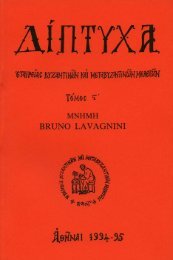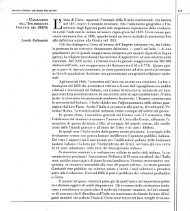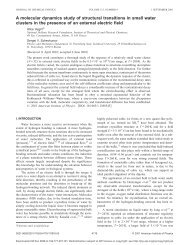Detection of human papilloma virus (HPV) and K-ras mutations in ...
Detection of human papilloma virus (HPV) and K-ras mutations in ...
Detection of human papilloma virus (HPV) and K-ras mutations in ...
Create successful ePaper yourself
Turn your PDF publications into a flip-book with our unique Google optimized e-Paper software.
INTERNATIONAL JOURNAL OF ONCOLOGY 8: 1089-1093, 1996<br />
<strong>Detection</strong> <strong>of</strong> <strong>human</strong> <strong>papilloma</strong> <strong>virus</strong> (<strong>HPV</strong>) <strong>and</strong> K-<strong>ras</strong><br />
<strong>mutations</strong> <strong>in</strong> <strong>human</strong> lung carc<strong>in</strong>omas<br />
A. NOUTSOU 1·2<br />
, M. KOFFA 1·3<br />
, M. ERGAZAKI 1·3<br />
, N.M. SIAFAKAS 1 <strong>and</strong> DA. SPANDIDOS 1·3<br />
Medical School, University <strong>of</strong> Crete, Heraklion; department <strong>of</strong> Pathology, 'Sismanoglion' General Hospital, Athens;<br />
Institute <strong>of</strong> Biological Research <strong>and</strong> Biotechnology, National Hellenic Research Foundation, Athens, Greece<br />
Contributed by D.A. Sp<strong>and</strong>idos, April 2, 1996<br />
Abstract. The purpose <strong>of</strong> our study was to assess the<br />
prevalence <strong>and</strong> prognostic significance <strong>of</strong> <strong>HPV</strong> <strong>in</strong>fection as<br />
well as K-<strong>ras</strong> codon 12 po<strong>in</strong>t <strong>mutations</strong> <strong>in</strong> lung cancer.<br />
Patients diagnosed with lung carc<strong>in</strong>oma between 1988 <strong>and</strong><br />
1992 (N=99) were selected. <strong>HPV</strong> detection <strong>and</strong> typ<strong>in</strong>g was<br />
performed by PCR from paraff<strong>in</strong>-embedded tissues, while<br />
<strong>mutations</strong> <strong>in</strong> codon 12 <strong>of</strong> K-<strong>ras</strong> gene were detected us<strong>in</strong>g the<br />
restriction fragment length polymorphism (RFLP) analysis. The<br />
prevalence <strong>of</strong> <strong>HPV</strong> <strong>in</strong>fection was 15%, while K-<strong>ras</strong> codon 12<br />
po<strong>in</strong>t <strong>mutations</strong> were found <strong>in</strong> 18% <strong>of</strong> the specimens exam<strong>in</strong>ed.<br />
In 50% <strong>of</strong> the <strong>HPV</strong>-positive cases, K-<strong>ras</strong> gene mutation coexisted.<br />
<strong>HPV</strong> 18 was the most frequent type. No correlation<br />
was found between K-<strong>ras</strong> mutation <strong>and</strong> <strong>HPV</strong> <strong>in</strong>fection with<br />
sex, age <strong>and</strong> cl<strong>in</strong>ical outcome <strong>of</strong> the patient, or the histological<br />
type <strong>and</strong> the differentiation grade <strong>of</strong> the tumor. An association<br />
was found between K-<strong>ras</strong> codon 12 po<strong>in</strong>t <strong>mutations</strong> <strong>and</strong> the<br />
stage <strong>of</strong> the tumor, occurr<strong>in</strong>g more frequently at stage III<br />
(p=0.037). Infection with potentially oncogenic <strong>HPV</strong> types<br />
could co-operate with K-<strong>ras</strong> gene activation <strong>in</strong> the<br />
progression <strong>of</strong> the disease, s<strong>in</strong>ce K-<strong>ras</strong> activation by po<strong>in</strong>t<br />
<strong>mutations</strong> seems to be a late event <strong>in</strong> lung carc<strong>in</strong>ogenesis.<br />
Introduction<br />
Carc<strong>in</strong>oma <strong>of</strong> the lung has become <strong>in</strong>creas<strong>in</strong>gly frequent dur<strong>in</strong>g<br />
the past 50 years. It is now the lead<strong>in</strong>g cause <strong>of</strong> cancer mortality<br />
<strong>in</strong> the Western world. This is due not only to <strong>in</strong>creased<br />
recognition through better radiographic, bronchoscopic <strong>and</strong><br />
cytologic techniques but also to an actual rise <strong>in</strong> <strong>in</strong>cidence.<br />
Carc<strong>in</strong>oma <strong>of</strong> the lung is associated with various environmental<br />
factors, most importantly smok<strong>in</strong>g <strong>and</strong> asbestos exposure (1-3).<br />
However, many heavy smokers rema<strong>in</strong> free <strong>of</strong> this disease or<br />
other smok<strong>in</strong>g-related cancers. It has been suggested that<br />
genetic factors may also contribute to the development <strong>of</strong> lung<br />
carc<strong>in</strong>oma. So far, no classical l<strong>in</strong>kage analysis that correlates<br />
Correspondence to: Pr<strong>of</strong>essor D.A. Sp<strong>and</strong>idos, Medical School,<br />
University <strong>of</strong> Crete, Heraklion 71409, Greece<br />
Key words: <strong>human</strong> <strong>papilloma</strong> <strong>virus</strong> (<strong>HPV</strong>), K-<strong>ras</strong> oncogene, lung<br />
carc<strong>in</strong>oma<br />
<strong>in</strong>cidence <strong>of</strong> the disease with the <strong>in</strong>heritance <strong>of</strong> genetic markers,<br />
has been reported for lung cancer (4).<br />
Dur<strong>in</strong>g recent years, a great deal <strong>of</strong> data has been<br />
accumulated on the role <strong>of</strong> <strong>HPV</strong> <strong>in</strong> the development <strong>of</strong><br />
carc<strong>in</strong>oma <strong>of</strong> different anatomical sites <strong>of</strong> the body. Molecular<br />
biology techniques have disclosed that there are at least 73<br />
different types <strong>and</strong> several subtypes <strong>of</strong> <strong>HPV</strong> (5,6). Most viral<br />
types are observed <strong>in</strong> anogenital tract <strong>and</strong> sk<strong>in</strong> lesions (7).<br />
<strong>HPV</strong> has also been detected <strong>in</strong> carc<strong>in</strong>omas <strong>of</strong> the oral <strong>and</strong><br />
nasal cavity (8), the male urethra (9), the ur<strong>in</strong>ary bladder (ΙΟ<br />
Ι 2), the esophagus <strong>and</strong> the respiratory tract.<br />
With regard to the upper respiratory tract, many types <strong>of</strong><br />
<strong>HPV</strong> (6, 11,16, 30) have been detected <strong>in</strong> laryngeal carc<strong>in</strong>omas<br />
(13,14). Clear etiological evidence <strong>in</strong>dicated that <strong>in</strong> laryngeal<br />
<strong>papilloma</strong>s <strong>in</strong>fection with <strong>HPV</strong> types 16 <strong>and</strong> 18 was associated<br />
with progression to malignant lesions, whereas <strong>HPV</strong> types 6b<br />
<strong>and</strong> 11 were usually associated with benign lesions (15).<br />
In the lower respiratory tract, the causative role <strong>of</strong> <strong>HPV</strong> was<br />
suggested by morphological data already <strong>in</strong> 1979: cytological<br />
<strong>and</strong> histological similarities with lesions from uter<strong>in</strong>e cervix<br />
condylomas were described <strong>in</strong> about 30% <strong>of</strong> bronchial<br />
epithelium next to <strong>in</strong>vasive bronchial squamous cell carc<strong>in</strong>oma<br />
(16) or well differentiated squamous cell carc<strong>in</strong>oma (17,18).<br />
<strong>HPV</strong> sequences have also been demonstrated <strong>in</strong> primary lung<br />
squamous cell carc<strong>in</strong>omas (19-21). Patients with squamous<br />
cell <strong>papilloma</strong>s exhibit<strong>in</strong>g <strong>HPV</strong> 16 or 18 positivity are at high<br />
risk for the development <strong>of</strong> squamous cell carc<strong>in</strong>oma. Virus<br />
typ<strong>in</strong>g seems to be a better prognostic <strong>in</strong>dicator than grad<strong>in</strong>g <strong>of</strong><br />
dysplasia or age relationship, while <strong>virus</strong> typ<strong>in</strong>g by the PCR is<br />
more sensitive compared with <strong>in</strong> situ hybridization (ISH) (22).<br />
Moreover, molecular tumor markers may <strong>of</strong>fer cl<strong>in</strong>ically<br />
useful tools for diagnostic <strong>and</strong> prognostic purposes <strong>in</strong> lung<br />
cancer (23). Ras genes are <strong>of</strong>ten found activated <strong>in</strong> a variety <strong>of</strong><br />
tumor types, although the <strong>in</strong>cidence varies greatly. K-<strong>ras</strong> gene<br />
is by far the most frequently <strong>in</strong>volved <strong>in</strong> lung tumors (24-27).<br />
Po<strong>in</strong>t <strong>mutations</strong> <strong>of</strong> the K-<strong>ras</strong> gene were observed primarily <strong>in</strong><br />
patients with a habit <strong>of</strong> smok<strong>in</strong>g. Patients with K-<strong>ras</strong> positive<br />
tumors have a significantly poorer prognosis than patients with<br />
K-<strong>ras</strong> negative tumors (28). There is evidence that K-<strong>ras</strong> gene<br />
may serve as a genetic marker not only <strong>in</strong> the early detection<br />
<strong>of</strong> lung cancer (29) but also <strong>in</strong> the differential diagnosis <strong>of</strong><br />
recurrence or metastasis versus second primaries <strong>of</strong> the lung<br />
(30). In addition strong overexpression <strong>of</strong> K-<strong>ras</strong> gene has been<br />
reported <strong>in</strong> a high <strong>in</strong>cidence <strong>of</strong> non-small cell lung carc<strong>in</strong>omas<br />
(31).
1090 NOUTSOU et al: <strong>HPV</strong> AND K-<strong>ras</strong> IN LUNG CARCINOMA<br />
In the current study, <strong>HPV</strong> detection <strong>and</strong> typ<strong>in</strong>g as well as<br />
detection <strong>of</strong> K-<strong>ras</strong> gene <strong>mutations</strong> was performed <strong>in</strong> 99 cases<br />
<strong>of</strong> lung carc<strong>in</strong>oma from paraff<strong>in</strong>-embedded tissues employ<strong>in</strong>g<br />
the PCR technique. 15% <strong>of</strong> the specimens were found positive<br />
for <strong>HPV</strong>, while 18% carried mutation <strong>in</strong> the codon 12 <strong>of</strong> the<br />
K-<strong>ras</strong> gene. It was also exam<strong>in</strong>ed whether such alterations<br />
correlate with cl<strong>in</strong>icopathological parameters or cl<strong>in</strong>ical<br />
outcome.<br />
Materials <strong>and</strong> methods<br />
Patients <strong>and</strong> specimens. The primary neoplasm specimens<br />
were excised either by surgical lobectomy or pneumonectomy<br />
<strong>and</strong> fixed <strong>in</strong> neutral formal<strong>in</strong>, at Sismanoglion General Hospital,<br />
Athens, between 1988-1992. Hematoxyl<strong>in</strong>-eos<strong>in</strong> sta<strong>in</strong>ed sections<br />
from all paraff<strong>in</strong>-embedded tissues exam<strong>in</strong>ed, were reviewed<br />
to reconfirm the tumor type, differentiation grade while representative<br />
blocks (one per case) were selected for further<br />
analysis.<br />
Eighty-seven <strong>of</strong> the 99 patients were smokers, 3 were nonsmokers<br />
<strong>and</strong> for the rema<strong>in</strong><strong>in</strong>g 9 no reliable data on smok<strong>in</strong>g<br />
habits were available. Most <strong>of</strong> the smokers were heavy smokers<br />
(>60 py). The age range was 44-77 years, <strong>and</strong> the mean age<br />
62.8 years.<br />
DNA extraction. Five or six 10 μηι thick sections from formal<strong>in</strong>fixed,<br />
paraff<strong>in</strong>-embedded tissues were lysed <strong>in</strong> 400 μΐ digestion<br />
buffer, conta<strong>in</strong><strong>in</strong>g 100 mM NaCl, 10 mM Tris-HCl, 25 raM<br />
EDTA, 0.5% SDS pH 8.0, 0.1 mg/ml prote<strong>in</strong>ase K. Samples<br />
were <strong>in</strong>cubated for 24 h at 37°C. Fresh prote<strong>in</strong>ase Κ was added<br />
<strong>and</strong> the <strong>in</strong>cubation was cont<strong>in</strong>ued for another 24 h. The samples<br />
were then extracted once with phenol/chlor<strong>of</strong>orm <strong>and</strong> once<br />
with chlor<strong>of</strong>orm. DNA was precipitated with the addition <strong>of</strong><br />
20 μΐ 5 M NaCl <strong>and</strong> 1 ml ethanol, recovered by centrifugation<br />
for 15 m<strong>in</strong> at 4°C, washed once with cold 70% ethanol <strong>and</strong><br />
resuspended <strong>in</strong> 30 μΐ double distilled water.<br />
Oligonucleotide primers <strong>and</strong> PCR amplification. For the<br />
detection <strong>and</strong> type dist<strong>in</strong>ction <strong>of</strong> the <strong>HPV</strong>, multiplex PCR was<br />
employed us<strong>in</strong>g four pairs <strong>of</strong> primers stimultaneously (for <strong>HPV</strong><br />
types 11, 16, 18 <strong>and</strong> 33), provid<strong>in</strong>g different lengths <strong>of</strong> amplified<br />
DNA for each <strong>virus</strong> type (32), while the results were confirmed<br />
us<strong>in</strong>g the general primers GP5 <strong>and</strong> GP6 (33) followed by Rsal<br />
digestion giv<strong>in</strong>g a different pattern for each type (34). The<br />
oligonucleotides used for K-<strong>ras</strong> have been previously described<br />
(35). One μΐ <strong>of</strong> the extracted DNA <strong>of</strong> each sample was amplified<br />
<strong>in</strong> a reaction solution <strong>of</strong> 50 μΐ conta<strong>in</strong><strong>in</strong>g 20 mM (NH 4<br />
) 2<br />
S0 4<br />
,<br />
2.0 mM MgCl 2<br />
, 75 mM Tris-HCl pH 9.0, 0.01% (w/v) Tween,<br />
200 μΜ <strong>of</strong> each dNTP, 0.5 μΜ <strong>of</strong> each primer <strong>and</strong> 1.25 U Taq<br />
polyme<strong>ras</strong>e (Advanced Biotechnologies). The mixture was<br />
heated for 1 m<strong>in</strong> at 95°C, <strong>and</strong> then subjected to 35 cycles <strong>of</strong><br />
amplification under the follow<strong>in</strong>g conditions.<br />
<strong>HPV</strong> amplification: Us<strong>in</strong>g the specific set <strong>of</strong> primers each<br />
cycle consisted <strong>of</strong> 50 sec at 94 °C, 40 sec at 56°C <strong>and</strong> 45 sec at<br />
72°C, <strong>in</strong>creas<strong>in</strong>g the elongation time 1 sec per cycle. To<br />
establish type specificity <strong>of</strong> primer-directed amplification, each<br />
set <strong>of</strong> primers was tested with template plasmid DNA <strong>of</strong> the<br />
five <strong>HPV</strong> types 6b, 11, 16, 18 <strong>and</strong> 33.<br />
Us<strong>in</strong>g the general primers GP5 <strong>and</strong> GP6 each cycle<br />
consisted <strong>of</strong> 50 sec at 94°C, 50 sec at 52°C <strong>and</strong> 40 sec at 72°C,<br />
<strong>in</strong>creas<strong>in</strong>g the elongation time 1 sec per cycle.<br />
K-<strong>ras</strong> amplification: Each cycle consisted <strong>of</strong> a denaturation<br />
step at 94°C for 50 sec, an anneal<strong>in</strong>g step at 58°C for 45 sec<br />
<strong>and</strong> an elongation step at 72°C for 50 sec, <strong>in</strong>creas<strong>in</strong>g the<br />
elongation time 1 sec per cycle.<br />
RFLP analysis. <strong>HPV</strong>-general primers: Confirmation <strong>of</strong> the<br />
typ<strong>in</strong>g was achieved by digestion <strong>of</strong> the amplification products<br />
with 30 U <strong>of</strong> Rsal giv<strong>in</strong>g a different pattern for each type.<br />
Digestion products were electrophoresed through a 10%<br />
Polyacrylamide gel. As control the amplified product <strong>of</strong> plasmid<br />
DNA <strong>of</strong> the <strong>HPV</strong> types 6b, 11, 16, 18 <strong>and</strong> 33 were used.<br />
K-<strong>ras</strong>; 10-20 μΐ were digested for 3 h with 30 U <strong>of</strong> BstNI.<br />
Digestion products were electrophoresed through an 8%<br />
Polyacrylamide gel. Gels were sta<strong>in</strong>ed with ethidium bromide<br />
<strong>and</strong> photographed on a UV light transillum<strong>in</strong>ator. Enzymes<br />
were supplied by New Engl<strong>and</strong> Biolabs <strong>and</strong> the conditions<br />
followed for digestions were those recommended by the<br />
supplier. Incubation temperatures were 37°C for Rsal <strong>and</strong><br />
60°C for BstNI.<br />
Statistical analysis. The presence <strong>of</strong> <strong>HPV</strong> <strong>and</strong> <strong>mutations</strong> at<br />
codon 12 <strong>of</strong> K-<strong>ras</strong> gene were analysed for significant correlation<br />
with histological type, grade, TNM stage <strong>and</strong> age at day <strong>of</strong><br />
operation, by Fisher's exact test. Survival curves were drawn up<br />
us<strong>in</strong>g the Kaplan-Meier method. Differences between survival<br />
times were analysed by the log rank method.<br />
Results<br />
In the current study we exam<strong>in</strong>ed 99 specimens from patients<br />
with lung carc<strong>in</strong>omas. Tumors were classified accord<strong>in</strong>g to their<br />
histological type: 41 adenocarc<strong>in</strong>omas, 41 squamous cell, 10<br />
undifferentiated large cell, 5 small cell <strong>and</strong> 2 adenosquamous<br />
carc<strong>in</strong>omas. Accord<strong>in</strong>g to the degree <strong>of</strong> histological<br />
differentiation: 7 well, 42 moderate <strong>and</strong> 33 poorly differentiated<br />
carc<strong>in</strong>omas. Tumors were also staged accord<strong>in</strong>g to the TNM<br />
system as: 46 <strong>in</strong> stage I, 37 <strong>in</strong> stage II <strong>and</strong> 16 <strong>in</strong> stage III.<br />
Follow-up was available for 42 patients. 32 have died <strong>of</strong> the<br />
disease while 10 patients are still alive (after 1-63 months<br />
follow<strong>in</strong>g surgery). Although no statistically significant<br />
correlations were found, the survival was shorter <strong>in</strong> patients<br />
with <strong>ras</strong> <strong>mutations</strong> (average survival 665.1 days), <strong>HPV</strong> <strong>in</strong>fection<br />
(a.s. 718.2 days) <strong>and</strong> <strong>HPV</strong> <strong>in</strong>fection simultaneously with <strong>ras</strong><br />
<strong>mutations</strong> (a.s. 773.1 days), compared to those with no such<br />
alterations (a.s. 929.7, 956.7 <strong>and</strong> 871.2 days respectively).<br />
The type <strong>of</strong> <strong>HPV</strong> as well as the presence <strong>of</strong> po<strong>in</strong>t <strong>mutations</strong><br />
<strong>in</strong> codon 12 <strong>of</strong> the K-<strong>ras</strong> gene were exam<strong>in</strong>ed. The results <strong>of</strong><br />
the PCR analysis are summarized <strong>in</strong> Table I.<br />
Fifteen <strong>of</strong> the 99 specimens (15%) were found positive for<br />
<strong>HPV</strong>. The prevalence <strong>of</strong> <strong>HPV</strong> <strong>in</strong>fection was 20% <strong>in</strong> adenocarc<strong>in</strong>omas,<br />
9.7% <strong>in</strong> squamous cell carc<strong>in</strong>omas, 20% <strong>in</strong> undifferentiated<br />
large cell carc<strong>in</strong>omas, while <strong>HPV</strong> was also<br />
found <strong>in</strong> one <strong>of</strong> the two adenosquamous carc<strong>in</strong>omas. Results<br />
from the type dist<strong>in</strong>ction <strong>of</strong> <strong>HPV</strong> (Fig. 1) <strong>in</strong>dicated that<br />
<strong>HPV</strong> 18 was the most frequent type (<strong>in</strong> 8% <strong>of</strong> the cases),<br />
while <strong>HPV</strong> 16 was found <strong>in</strong> 4%, <strong>HPV</strong> 11 <strong>in</strong> 3% <strong>and</strong> <strong>HPV</strong> 33 <strong>in</strong><br />
2% <strong>of</strong> the cases exam<strong>in</strong>ed (Table II). Samples found positive<br />
with the multiplex PCR (amplify<strong>in</strong>g a region from the E6<br />
ORF) were also positive with the general primer PCR,<br />
<strong>in</strong>dicat<strong>in</strong>g that the LI region was present.
INTERNATIONAL JOURNAL OF ONCOLOGY 8: 1089-1093, 1996 1091<br />
Table I. <strong>Detection</strong> <strong>of</strong> <strong>HPV</strong> <strong>and</strong> K-<strong>ras</strong> codon 12 po<strong>in</strong>t <strong>mutations</strong> <strong>in</strong> lung carc<strong>in</strong>omas by PCR.<br />
Histological<br />
type<br />
No. <strong>of</strong><br />
patients<br />
<strong>HPV</strong><br />
positive (%)<br />
K-<strong>ras</strong><br />
<strong>mutations</strong> (%)<br />
<strong>HPV</strong>+K-<strong>ras</strong><br />
(%)<br />
Adenocarc<strong>in</strong>oma<br />
41<br />
8 (20)<br />
8 (20)<br />
4 (9.8)<br />
Squamous cell carc<strong>in</strong>oma<br />
Undifferentiated large cell carc<strong>in</strong>oma<br />
Small cell carc<strong>in</strong>oma<br />
Adenosquamous carc<strong>in</strong>oma<br />
41<br />
to<br />
5<br />
2<br />
4 (9.8)<br />
2 (20)<br />
0<br />
1<br />
7 (17)<br />
2 (20)<br />
0<br />
1<br />
3 (7.3)<br />
1 (10)<br />
0<br />
1<br />
Total<br />
99<br />
15 (15)<br />
18 (18)<br />
9 (9.1)<br />
M 1 2 3 4 5 6 7 8 9 10 11 12 M<br />
bp<br />
315<strong>HPV</strong>-16<br />
236<strong>HPV</strong>-11<br />
171 <strong>HPV</strong>-33<br />
143 <strong>HPV</strong>-18<br />
157<br />
142 (mt)<br />
113 (wt)<br />
Figure l. Type dist<strong>in</strong>ction <strong>of</strong> <strong>HPV</strong> employ<strong>in</strong>g a multiplex PCR. Products <strong>of</strong><br />
different size (315 bp, <strong>HPV</strong> 16; 236 bp, <strong>HPV</strong> 11; 171 bp, <strong>HPV</strong>33; <strong>and</strong> 143 bp,<br />
<strong>HPV</strong> 18) were analysed by agarose gel electrophoresis. Lane M, molecular<br />
weight marker pUC18/HaeIII; lane 1, sample positive for <strong>HPV</strong> 11; lanes<br />
2,6, samples positive for <strong>HPV</strong> 18; lanes 3,7, samples positive for <strong>HPV</strong> 16;<br />
lane 4, sample positive for <strong>HPV</strong> 33; lane 5, sample positive for <strong>HPV</strong> 16-<br />
<strong>HPV</strong> 11.<br />
Figure 2. K-<strong>ras</strong> amplification products (157 bp) were digested with the<br />
restriction endonuclease BstNI <strong>and</strong> electrophoresed through an 8%<br />
Polyacrylamide gel. Lanes M, molecular weight marker pUCl8/HaeIII;<br />
lanes 1,11, positive control SW480 cell l<strong>in</strong>e (142 bp); lanes 2,12, undigested<br />
PCR product; lane 3, negative control; lanes 4,7-9, positive samples; lanes<br />
5,6,10, negative samples (113 bp).<br />
Table II. Incidence <strong>of</strong> <strong>HPV</strong> type <strong>in</strong> primary lung carc<strong>in</strong>omas.<br />
Type <strong>of</strong> <strong>HPV</strong><br />
<strong>HPV</strong> 18<br />
<strong>HPV</strong> 16<br />
<strong>HPV</strong> 11<br />
<strong>HPV</strong> 33<br />
a <strong>in</strong> a total <strong>of</strong> 99 samples.<br />
<strong>HPV</strong> positive carc<strong>in</strong>omas"<br />
K-<strong>ras</strong> codon 12 po<strong>in</strong>t <strong>mutations</strong> were found <strong>in</strong> 18 <strong>of</strong> the<br />
99 specimens (18%) exam<strong>in</strong>ed (Fig. 2). Mutations were found<br />
<strong>in</strong> 8 (20%) <strong>of</strong> the 41 cases <strong>of</strong> adenocarc<strong>in</strong>oma, <strong>in</strong> 7 (17%) <strong>of</strong><br />
the 41 cases <strong>of</strong> squamous cell carc<strong>in</strong>oma, <strong>in</strong> 2 (20%) <strong>of</strong> the<br />
10 cases <strong>of</strong> undifferentiated large cell carc<strong>in</strong>oma <strong>and</strong> <strong>in</strong> 1 <strong>of</strong><br />
the 2 cases <strong>of</strong> adenosquamous carc<strong>in</strong>oma.<br />
The simultaneous presence <strong>of</strong> <strong>HPV</strong> DNA <strong>and</strong> K-<strong>ras</strong><br />
mutation was observed <strong>in</strong> almost 50% <strong>of</strong> the <strong>HPV</strong> positive<br />
cases: <strong>in</strong> 9.8% <strong>of</strong> adenocarc<strong>in</strong>omas, <strong>in</strong> 7.3% <strong>of</strong> squamous cell<br />
carc<strong>in</strong>omas, <strong>in</strong> 10% <strong>of</strong> undifferentiated large cell carc<strong>in</strong>omas<br />
<strong>and</strong> <strong>in</strong> one <strong>of</strong> the two adenosquamous carc<strong>in</strong>omas.<br />
No correlation was found between <strong>HPV</strong> <strong>in</strong>fection <strong>and</strong> K-<strong>ras</strong><br />
mutation either with sex <strong>and</strong> age <strong>of</strong> the patient, or the histological<br />
type <strong>and</strong> the differentiation grade <strong>of</strong> the tumor. Survival curves<br />
4<br />
3<br />
2<br />
determ<strong>in</strong>ed by Kaplan-Meier method demonstrated that <strong>HPV</strong><br />
<strong>in</strong>fection <strong>and</strong> codon 12 po<strong>in</strong>t mutation <strong>of</strong> K-<strong>ras</strong> gene did not<br />
correlate with the cl<strong>in</strong>ical outcome <strong>of</strong> the patients. An association<br />
was found between K-<strong>ras</strong> codon 12 po<strong>in</strong>t <strong>mutations</strong> <strong>and</strong> the<br />
stage <strong>of</strong> the tumor, occur<strong>in</strong>g more frequently at stage III<br />
(p=0.037) than stage I. These data suggest that <strong>in</strong>fection with<br />
potentially oncogenic <strong>HPV</strong> types could be associated not only<br />
with anogenital tumors, but also with a subset <strong>of</strong> lung tumours,<br />
while <strong>HPV</strong> could co-operate with K-<strong>ras</strong> <strong>mutations</strong> <strong>in</strong> the<br />
progression <strong>of</strong> the disease.<br />
Discussion<br />
The potential role <strong>of</strong> <strong>HPV</strong> <strong>in</strong> the development <strong>of</strong> lung<br />
carc<strong>in</strong>omas emerged after the description <strong>of</strong> condylomatouslike<br />
lesions <strong>in</strong> the bronchial epithelium adjacent to squamous<br />
cell carc<strong>in</strong>omas. Intranuclear <strong>HPV</strong>-like particles were<br />
demonstrated by electron microscopy <strong>in</strong> squamous cell<br />
<strong>papilloma</strong>s <strong>of</strong> the bronchus (36).<br />
The presence <strong>of</strong> <strong>HPV</strong> <strong>in</strong> lung carc<strong>in</strong>omas has been reported<br />
<strong>in</strong> several studies. The rate <strong>of</strong> positivity varied between 4.2%<br />
<strong>and</strong> 31% (19-21), while <strong>in</strong> carc<strong>in</strong>omas with condylomatous<br />
changes the rate was higher (42%) (20). In cont<strong>ras</strong>t other<br />
<strong>in</strong>vestigators reported absence <strong>of</strong> <strong>HPV</strong> <strong>in</strong> lung cancer (37,38),<br />
this divergence may be due to the differences <strong>in</strong> the sensitivity<br />
<strong>and</strong> specificity <strong>of</strong> the methods applied, as well as to epidemio-
1092 NOUTSOU et al: <strong>HPV</strong> AND K-<strong>ras</strong> IN LUNG CARCINOMA<br />
logical factors. In the current study we confirm the presence<br />
<strong>of</strong> <strong>HPV</strong> <strong>in</strong> lung carc<strong>in</strong>omas, us<strong>in</strong>g primers from both the E6 <strong>and</strong><br />
LI ORFs. The use <strong>of</strong> primers located <strong>in</strong> the E6 ORF, which<br />
rema<strong>in</strong>s <strong>in</strong>tact <strong>in</strong> the case <strong>of</strong> high risk <strong>HPV</strong> type <strong>in</strong>tegration<br />
<strong>in</strong>to the host genome, allows better diagnostic sensitivity. No<br />
difference was found <strong>in</strong> the detection rate <strong>of</strong> the <strong>virus</strong> us<strong>in</strong>g<br />
the two sets <strong>of</strong> primers from the E6 <strong>and</strong> LI ORFs.<br />
It is noteworthy that <strong>HPV</strong> was also detected <strong>in</strong> cases <strong>of</strong><br />
adenocarc<strong>in</strong>oma. Recently, there has been <strong>in</strong>creas<strong>in</strong>g <strong>in</strong>terest<br />
<strong>in</strong> the association between <strong>HPV</strong> <strong>and</strong> gl<strong>and</strong>ular neoplasia. In<br />
many studies <strong>HPV</strong> DNA has been found <strong>in</strong> adenocarc<strong>in</strong>omas<br />
<strong>and</strong> adenosquamous carc<strong>in</strong>omas as frequently as <strong>in</strong> squamous<br />
cell carc<strong>in</strong>omas <strong>of</strong> the cervix (39-41).<br />
In our study we found that multiple subtypes <strong>of</strong> <strong>HPV</strong> may be<br />
related to lung cancer. However <strong>HPV</strong> 18 was the predom<strong>in</strong>ant<br />
type, which is <strong>in</strong> agreement with other studies report<strong>in</strong>g that<br />
high-risk <strong>HPV</strong> types were more frequently detected (19,20,22).<br />
Their identification <strong>in</strong> both squamous cell carc<strong>in</strong>omas <strong>and</strong><br />
adenocarc<strong>in</strong>omas as well as <strong>in</strong> adenosquamous <strong>and</strong> undifferentiated<br />
large cell carc<strong>in</strong>omas suggests a key role <strong>in</strong> the<br />
process <strong>of</strong> lung carc<strong>in</strong>ogenesis. Moreover, it has been suggested<br />
that <strong>in</strong>fection with high risk <strong>HPV</strong>s could serve as a prognostic<br />
<strong>in</strong>dicator <strong>of</strong> malignant progression <strong>in</strong> lung squamous cell<br />
<strong>papilloma</strong>s (22).<br />
Multiple molecular changes have also been documented<br />
<strong>in</strong> lung cancer. These <strong>in</strong>clude activation <strong>of</strong> dom<strong>in</strong>ant oncogenes,<br />
such as the <strong>ras</strong> gene family (23), myc <strong>and</strong> HER-2/new<br />
genes, as well as loss <strong>of</strong> recessive growth regulatory genes,<br />
or onco-suppressor genes (p53, rb) (23,26).<br />
Several studies have reported an <strong>in</strong>cidence <strong>of</strong> 15-33% <strong>of</strong><br />
activated K-<strong>ras</strong> gene <strong>in</strong> lung carc<strong>in</strong>omas, while more recent<br />
studies have revealed a higher <strong>in</strong>cidence <strong>of</strong> more than 50%<br />
(42-44). In the current study we found K-<strong>ras</strong> codon 12 po<strong>in</strong>t<br />
<strong>mutations</strong> <strong>in</strong> 18% <strong>of</strong> the specimens exam<strong>in</strong>ed. In cases <strong>of</strong><br />
squamous cell carc<strong>in</strong>omas the <strong>in</strong>cidence <strong>of</strong> K-<strong>ras</strong> <strong>mutations</strong><br />
was higher than <strong>in</strong> other studies (24,42), propably due to the<br />
more sensitive assay used. Activation <strong>of</strong> the K-<strong>ras</strong> gene was<br />
exam<strong>in</strong>ed, s<strong>in</strong>ce po<strong>in</strong>t <strong>mutations</strong> <strong>of</strong> this member <strong>of</strong> the <strong>ras</strong><br />
family are found more commonly <strong>in</strong> lung cancer <strong>and</strong> occur<br />
predom<strong>in</strong>antly at codon 12.<br />
It has been suggested that K-<strong>ras</strong> <strong>mutations</strong> arise predom<strong>in</strong>antly<br />
at the non-<strong>in</strong>vasive stage <strong>of</strong> lung carc<strong>in</strong>ogenesis,<br />
<strong>and</strong> may be associated with the transformation <strong>of</strong> dysplastic<br />
cells to neoplastic (45). Moreover, detection <strong>of</strong> K-<strong>ras</strong> <strong>mutations</strong><br />
<strong>in</strong> sputum may precede diagnosis <strong>of</strong> lung cancer (29). On the<br />
other h<strong>and</strong>, a significant number <strong>of</strong> lung adenocarc<strong>in</strong>omas<br />
harbor <strong>ras</strong> <strong>mutations</strong> <strong>in</strong> only a small percentage <strong>of</strong> the cancer<br />
cells, <strong>in</strong>dicat<strong>in</strong>g that K-<strong>ras</strong> <strong>mutations</strong> represent a late event <strong>in</strong><br />
lung carc<strong>in</strong>ogenesis (23). This concept is consistent with the<br />
association <strong>of</strong> <strong>ras</strong> <strong>mutations</strong> with <strong>in</strong>creased tumor growth <strong>and</strong><br />
<strong>in</strong>vasiveness, as suggested by the poorer prognosis <strong>of</strong> mutationpositive<br />
than mutation-negative cases treated by surgical<br />
resection (44,46). We found an association between K-<strong>ras</strong><br />
<strong>mutations</strong> <strong>and</strong> the stage <strong>of</strong> the tumor, occur<strong>in</strong>g more frequently<br />
at cases with stage III. However, no correlation was found<br />
between K-<strong>ras</strong> <strong>mutations</strong> <strong>and</strong> the cl<strong>in</strong>ical outcome <strong>of</strong> the<br />
patients exam<strong>in</strong>ed. In 50% <strong>of</strong> the <strong>HPV</strong>-positive cases, K-<strong>ras</strong><br />
mutation co-existed. This might suggest that <strong>HPV</strong> <strong>in</strong>fection<br />
is not sufficient by itself for malignant transformation, but<br />
requires co-operation <strong>of</strong> an activated <strong>ras</strong> gene. In addition,<br />
carc<strong>in</strong>ogen exposure may <strong>in</strong>duce transformation <strong>in</strong> several<br />
fields <strong>of</strong> the bronchial epithelium through the <strong>in</strong>duction <strong>of</strong><br />
different genetic changes.<br />
Our results <strong>in</strong>dicate that <strong>HPV</strong> <strong>in</strong>fection <strong>and</strong> K-<strong>ras</strong> gene<br />
activation may play a role <strong>in</strong> a subset <strong>of</strong> lung tumors. The<br />
possibility <strong>of</strong> synergic mechanisms between <strong>HPV</strong>, <strong>ras</strong> gene<br />
<strong>mutations</strong> <strong>and</strong> chemical or physical carc<strong>in</strong>ogens such as cigarette<br />
smok<strong>in</strong>g should also be considered.<br />
References<br />
1. Loeb LA, Ernster VL, Warner KE, Abbotts J <strong>and</strong> Laszio J:<br />
Smok<strong>in</strong>g <strong>and</strong> lung cancer: an overview. Cancer Res 44: 5940-5958,<br />
1984.<br />
2. Kvale G, Bjelke E <strong>and</strong> Heuch I: Occupational exposure <strong>and</strong><br />
lung cancer risk. Int J Cancer 37: 185-193, 1986.<br />
3. Selik<strong>of</strong>f 1J, Hammond EC <strong>and</strong> Chyrg J: Asbestos exposure,<br />
smok<strong>in</strong>g <strong>and</strong> neoplasia. JAMA 204: 106-112, 1968.<br />
4. Rabbitts PH: Genetic changes <strong>in</strong> the development <strong>of</strong> lung<br />
cancer. Br Med Bull 50: 688-697, 1994.<br />
5. zur Hausen H <strong>and</strong> de Villiers EM: Human <strong>papilloma</strong><strong>virus</strong>es.<br />
Annu Rev Microbiol 48: 427-447, 1994.<br />
6. Vousden KH: Viruses <strong>and</strong> <strong>human</strong> cancer. Br Med Bull 50:<br />
560-581, 1994.<br />
7. zur Hausen H: Human <strong>papilloma</strong><strong>virus</strong> <strong>in</strong> the pathogenesis <strong>of</strong><br />
anogenital cancer. Virology 184: 9-13, 1991.<br />
8. Furuta Y, Takasu T, Asai T, Sh<strong>in</strong>ohara T, Sawa H, Nagashima Κ<br />
<strong>and</strong> Inuyama Y: <strong>Detection</strong> <strong>of</strong> <strong>human</strong> <strong>papilloma</strong><strong>virus</strong> DNA <strong>in</strong><br />
carc<strong>in</strong>omas <strong>of</strong> the nasal cavities <strong>and</strong> paranasal s<strong>in</strong>uses by<br />
polyme<strong>ras</strong>e cha<strong>in</strong> reaction. Cancer 69: 353-357, 1992.<br />
9. Wiener JS, Liu ET <strong>and</strong> Walther PJ: Oncogenic <strong>human</strong> <strong>papilloma</strong><strong>virus</strong><br />
type 16 is associated with squamous cell cancer <strong>of</strong> the<br />
male urethra. Cancer Res 52: 5018-5023, 1992.<br />
10. Anwar K, Naiki H, Nakakuki Κ <strong>and</strong> Inzuzuka M: High frequency<br />
<strong>of</strong> <strong>human</strong> <strong>papilloma</strong><strong>virus</strong> <strong>in</strong>fection <strong>in</strong> carc<strong>in</strong>oma <strong>of</strong> the ur<strong>in</strong>ary<br />
bladder. Cancer 70: 1967-1973, 1992.<br />
11. Noel JC, Thiry L, Verhest A, Deschepper N, Peny MO, Sattar AA,<br />
Schulman CC <strong>and</strong> Haot J: Transitional cell carc<strong>in</strong>oma <strong>of</strong> the<br />
bladder evaluation <strong>of</strong> the role <strong>of</strong> <strong>human</strong> <strong>papilloma</strong><strong>virus</strong>es. Urology<br />
44:671-675, 1994.<br />
12. Maloney K, Wiener Η <strong>and</strong> Walter PH: Oncogenic <strong>human</strong><br />
<strong>papilloma</strong><strong>virus</strong>es are rarely associated with squamous cell<br />
carc<strong>in</strong>oma <strong>of</strong> the bladder: evaluation by differential polyme<strong>ras</strong>e<br />
cha<strong>in</strong> reaction. J Urol 154: 360-364, 1994.<br />
13. Hoshikawa T, Nakajima T, Uhara H, Gotoh M, Shimosato Y,<br />
Tsutsumi K, Ono I <strong>and</strong> Ebihara S: <strong>Detection</strong> <strong>of</strong> <strong>human</strong> <strong>papilloma</strong><strong>virus</strong><br />
DNA <strong>in</strong> laryngeal squamous cell carc<strong>in</strong>omas by polyme<strong>ras</strong>e<br />
cha<strong>in</strong> reaction. Laryngoscope 100: 647-650, 1990.<br />
14. Perez-Ayala M, Ruiz-Cabello F, Esteban F, Concha A, Redondo M,<br />
Oliva MR, Cabrera Τ <strong>and</strong> Garrido F: Presence <strong>of</strong> <strong>HPV</strong> 16<br />
sequences <strong>in</strong> laryngeal carc<strong>in</strong>omas. Int J Pathol 46: 8-11, 1990.<br />
15. McCance DJ: News on <strong>papilloma</strong><strong>virus</strong>es. Nature 335: 765-766,<br />
1988.<br />
16. Syrjänen KJ: Condylomatous changes <strong>in</strong> neoplastic bronchial<br />
epithelium: report <strong>of</strong> a case. Respiration 98: 299-304, 1979.<br />
17. Syrjänen KJ: Bronchial squamous cell carc<strong>in</strong>omas associated<br />
with epithelial changes identical to condylomatous lesions <strong>of</strong><br />
uter<strong>in</strong>e cervix. Lung 158: 131-142, 1980.<br />
18. Syrjänen KJ: Epithelial lesions suggestive <strong>of</strong> a condylomatous<br />
orig<strong>in</strong> found closely associated with <strong>in</strong>vasive bronchial squamous<br />
cell carc<strong>in</strong>omas. Respiration 40: 150-160, 1980.<br />
19. Yousem SA, Ohori NP <strong>and</strong> Sonmez-Alpan'E: Occurence <strong>of</strong><br />
<strong>human</strong> <strong>papilloma</strong><strong>virus</strong> DNA <strong>in</strong> primary lung neoplasms. Cancer<br />
69: 693-697, 1992.<br />
20. Bejui-Thivolet F, Liagre N, Chignol M, Chardonnet Y <strong>and</strong><br />
Patricot L: <strong>Detection</strong> <strong>of</strong> <strong>human</strong> <strong>papilloma</strong><strong>virus</strong> DNA <strong>in</strong> squamous<br />
bronchial metaplasia <strong>of</strong> the lung by <strong>in</strong> situ hybridization us<strong>in</strong>g<br />
biot<strong>in</strong>ylated probes <strong>in</strong> paraff<strong>in</strong>-embedded specimens. Hum<br />
Pathol 21: 111-116, 1990.<br />
21. Bejui-Thivolet F, Chardonnet Y <strong>and</strong> Patricot L: Human <strong>papilloma</strong><strong>virus</strong><br />
type 11 DNA <strong>in</strong> papillary squamous cell lung carc<strong>in</strong>oma.<br />
Virchows Arch (A) 417: 457-461, 1990.<br />
22. Popper HH, El-Shabrawi Y, Wöckel W, Höfler G, Kenner L,<br />
Freya, Juttner-Smole <strong>and</strong> Pongratz MG: Prognostic importance<br />
<strong>of</strong> <strong>human</strong> <strong>papilloma</strong><strong>virus</strong> typ<strong>in</strong>g <strong>in</strong> squamous cell carc<strong>in</strong>oma <strong>of</strong><br />
the bronchus. Hum Pathol 25: 1191-1197, 1994.
INTERNATIONAL JOURNAL OF ONCOLOGY 8: 1089-1093, 1996 1093<br />
23. Anderson MLM <strong>and</strong> Sp<strong>and</strong>idos DA: Oncogenes <strong>and</strong> oncosuppressor<br />
genes <strong>in</strong> lung cancer. Rcsp Med 87: 413-420, 1993.<br />
24. Kiaris H <strong>and</strong> Sp<strong>and</strong>idos DA: Mutations <strong>of</strong> <strong>ras</strong> genes <strong>in</strong> <strong>human</strong><br />
tumours (review). Int J Oncol 7: 413-421, 1995.<br />
25. Neville EM, Ellison G, Kiaris H, Stewart M, Sp<strong>and</strong>idos DA <strong>and</strong><br />
Field JK: <strong>Detection</strong> <strong>of</strong> K-<strong>ras</strong> <strong>mutations</strong> <strong>in</strong> non-small cell lung<br />
carc<strong>in</strong>oma. Int J Oncol 7: 511-514, 1995.<br />
26. Kiaris H, Ergazaki M, Sakkas S, Athanasiadou E <strong>and</strong><br />
Sp<strong>and</strong>idos DA: <strong>Detection</strong> <strong>of</strong> activat<strong>in</strong>g <strong>mutations</strong> <strong>in</strong> the <strong>ras</strong> family<br />
gene <strong>in</strong> cytological specimens from lung tumours. Oncol Rep 2:<br />
769-772, 1995.<br />
27. Mills NE, Fishman CL, Rom WN, Dub<strong>in</strong> Ν <strong>and</strong> Jacobson DR:<br />
Increased prevalence <strong>of</strong> K-<strong>ras</strong> oncogene <strong>mutations</strong> <strong>in</strong> lung adenocarc<strong>in</strong>oma.<br />
Cancer Res 55: 1444-1447, 1995.<br />
28. Slebos RJ, Kibbelaar RE, Dalesio O, Kooistra A, Stam J,<br />
Mcijer CJ, Wagenaar SS, V<strong>and</strong>erschueren RG, van Z<strong>and</strong>ijk N,<br />
Mooi WJ, Bos JL <strong>and</strong> Rodenhuis S: K-rai oncogene activation<br />
as a prognostic marker <strong>in</strong> adenocarc<strong>in</strong>oma <strong>of</strong> the lung. Ν Engl J<br />
Med 323: 561-565, 1990.<br />
29. Mao L, Hruban H, Boyle JO, Tockman M <strong>and</strong> Sidransky D:<br />
<strong>Detection</strong> <strong>of</strong> oncogene <strong>mutations</strong> <strong>in</strong> sputum precedes diagnosis<br />
<strong>in</strong> lung cancer. Cancer Res 54: 1634-1637, 1994.<br />
30. Sozzi G, Miozzo M, Pastor<strong>in</strong>o U, Pilotti S, Donghi R, Giarda M,<br />
De-Gregorio L, Manenti G, Radice Ρ, M<strong>in</strong>oletti F, Della Porta G<br />
<strong>and</strong> Pierotli MA: Genetic evidence for an <strong>in</strong>dependent orig<strong>in</strong> <strong>of</strong><br />
multiple preneoplastic <strong>and</strong> neoplastic lung lesions. Cancer Res<br />
55: 135-140, 1995.<br />
31. Lorenz J, Friedberg Τ, Oesch F <strong>and</strong> Ferl<strong>in</strong>z R: Oncogene overexpression<br />
<strong>in</strong> non-small cell lung cancer tissue: prevalence <strong>and</strong><br />
cl<strong>in</strong>icopathological significance. Cl<strong>in</strong> Investigator 72: 156-163,<br />
1994.<br />
32. Arends MJ, Donaldson YK, Duvall E, Wyllie AH <strong>and</strong> Bird CC:<br />
<strong>HPV</strong> <strong>in</strong> full thickness cervical biopsies: high prevalence <strong>in</strong><br />
CIN 2 <strong>and</strong> CIN 3 detected by a sensitive PCR method. J Pathol<br />
165:301-309, 1991.<br />
33. Snijders PJF, van den Brule AJC, Schrijnemakers HFJ, Snow G,<br />
Meijer CJLM <strong>and</strong> Walboomers JMM: The use <strong>of</strong> general primers<br />
<strong>in</strong> the polyme<strong>ras</strong>e cha<strong>in</strong> reaction permits the detection <strong>of</strong> a<br />
broad spectrum <strong>of</strong> <strong>human</strong> <strong>papilloma</strong><strong>virus</strong> genotypes. J Gen<br />
Virol 71: 173-181, 1990.<br />
34. K<strong>of</strong>fa M, Koumantakis E, Ergazaki M, Malamou-Mitsi V <strong>and</strong><br />
Sp<strong>and</strong>idos DA: <strong>Detection</strong> <strong>of</strong> <strong>ras</strong> gene <strong>mutations</strong> <strong>and</strong> <strong>HPV</strong> <strong>in</strong><br />
lesions <strong>of</strong> the <strong>human</strong> female reproductive tract. Int J Oncol 5:<br />
189-195, 1994.<br />
35. Sp<strong>and</strong>idos DA, Liloglou T, Arvanitis D <strong>and</strong> Gourtsoyiannis NC:<br />
Ras gene activation <strong>in</strong> <strong>human</strong> small <strong>in</strong>test<strong>in</strong>al tumors. Int J<br />
Oncol 2: 513-518, 1993.<br />
36. Br<strong>and</strong>we<strong>in</strong> M, Ste<strong>in</strong>berg Β, Thung S, et al: Human <strong>papilloma</strong><strong>virus</strong><br />
6/11 <strong>and</strong> 16/18 <strong>in</strong> Schnciderian <strong>in</strong>verted <strong>papilloma</strong>s. In<br />
situ hybridization with <strong>human</strong> <strong>papilloma</strong><strong>virus</strong> RNA probes.<br />
Cancer 63: 1708-1713, 1989.<br />
37. Szabo I, Sepp R, Nakamoto K, Maeda M, Sakamoto H <strong>and</strong> Uda H:<br />
Human <strong>papilloma</strong><strong>virus</strong> not found <strong>in</strong> squamous <strong>and</strong> large cell lung<br />
carc<strong>in</strong>omas by polyme<strong>ras</strong>e cha<strong>in</strong> reaction. Cancer 73: 2740-2744,<br />
1994.<br />
38. Shaman<strong>in</strong> V, Delius H <strong>and</strong> de Villiers EM: Development <strong>of</strong> a<br />
broad spectrum PCR assay for <strong>papilloma</strong> <strong>virus</strong>es <strong>and</strong> its application<br />
<strong>in</strong> screen<strong>in</strong>g lung cancer biopsies. J Gen Virol 75: 1149-1156,<br />
1994.<br />
39. Cooper K, Herr<strong>in</strong>gton CS, Evans MF <strong>and</strong> McGee JOD: Integration<br />
<strong>of</strong> <strong>human</strong> <strong>papilloma</strong><strong>virus</strong> types 16 <strong>and</strong> 18 <strong>in</strong> cervical adenocarc<strong>in</strong>oma.<br />
J Cl<strong>in</strong> Pathol 45: 382-384, 1992.<br />
40. Johnson TL, Kim W, Plieth DA <strong>and</strong> Sarkar FH: Detecion <strong>of</strong><br />
<strong>HPV</strong> 16/18 <strong>in</strong> cervical adenocarc<strong>in</strong>oma us<strong>in</strong>g polyme<strong>ras</strong>e cha<strong>in</strong><br />
reaction methodology. Modern Pathol 5: 35-40, 1992.<br />
41. Duggan MA, Benoit JL, McGregor SE, Nation JG, Inoue M <strong>and</strong><br />
Stuart GCE: The <strong>human</strong> <strong>papilloma</strong><strong>virus</strong> status <strong>of</strong> 114 endocervical<br />
adenocarc<strong>in</strong>oma cases by dot blot hybridization. Hum Pathol<br />
24: 121-125, 1993.<br />
42. Li S, Roseli R, Urban A, Fontan A, Ariza A, Armengol P, Abad A,<br />
Navas JJ <strong>and</strong> Monzo M: K-<strong>ras</strong> gene po<strong>in</strong>t mutation: a stable<br />
tumor marker <strong>in</strong> non-small cell lung carc<strong>in</strong>oma. Lung Cancer<br />
11: 19-27, 1994.<br />
43. Mitsudomi T, Viallet J, Mulsh<strong>in</strong>e JL, L<strong>in</strong>noila RI, M<strong>in</strong>na JD<br />
<strong>and</strong> Gazdar AF: Mutations <strong>of</strong> <strong>ras</strong> genes dist<strong>in</strong>guish a subset <strong>of</strong><br />
non-small cell lung cancer cell l<strong>in</strong>es from small-cell lung cancer<br />
cell l<strong>in</strong>es. Oncogene 6: 1353-1362, 1991.<br />
44. Sugio K, Ishida T, Yokoyama H, Inoue T, Sugimachi Κ <strong>and</strong><br />
Sadazuki T: <strong>ras</strong> gene <strong>mutations</strong> as a prognostic marker <strong>in</strong> adenocarc<strong>in</strong>oma<br />
<strong>of</strong> the <strong>human</strong> lung without lymph node metastasis.<br />
Cancer Res 52: 2903-2906, 1992.<br />
45. Sugio K, Kishimotto Y, Virmani AK, Hung JY <strong>and</strong> Gazdar AF:<br />
K-<strong>ras</strong> gene <strong>mutations</strong> are a relatively late event <strong>in</strong> the pathogenesis<br />
<strong>of</strong> lung carc<strong>in</strong>omas. Cancer Res 54: 5811-5815, 1994.<br />
46. Mitsudomi T, Ste<strong>in</strong>berg SM, Oie HK, Mulsh<strong>in</strong>e JL, Phelps R,<br />
Viallet J, Pass H, M<strong>in</strong>na JD <strong>and</strong> Gazdar AF: <strong>ras</strong> gene <strong>mutations</strong><br />
<strong>in</strong> non-small lung cancers are associated with shortened survival<br />
irrespective <strong>of</strong> treatment <strong>in</strong>tent. Cancer Res 51: 4999-5002,<br />
1991.
















